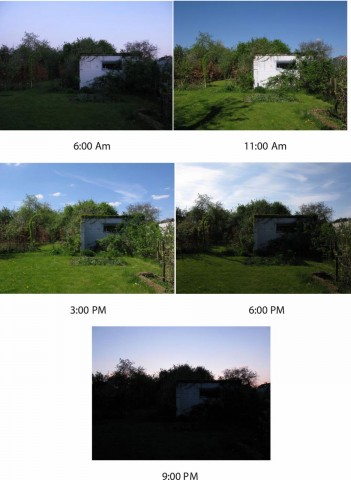 In February 2015, the world nearly went to nuclear war over the colour of a dress, future historians will declare. Oh, no, it didn’t? Well, what’s wrong with a little exaggeration, it is the Internet after all, nobody expects accuracy. But here at FamiLife we dug a little deeper to find out why some people saw blue and black while others saw white and gold.
In February 2015, the world nearly went to nuclear war over the colour of a dress, future historians will declare. Oh, no, it didn’t? Well, what’s wrong with a little exaggeration, it is the Internet after all, nobody expects accuracy. But here at FamiLife we dug a little deeper to find out why some people saw blue and black while others saw white and gold.

Changes in light reflect off building. Image: JOV
In the case of The Dress, scientists have tried to explain what happened. Three papers have been published in the journal Current Biology, each explaining why different people saw varying colors.
In the first study, Michael Webster, a psychologist from the University of Nevada in the US, blames the confusion on the ambiguity of the color blue. He said that people are generally unable to absolutely distinguish whether an object is blue in color or it is some other color with blue light reflecting off of it. On the other hand, it is easier for people with the color red. Individuals can clearly identify a white paper in red light, but the process does not work easily for all colors, such as blue.
An article in the New York Times says that in his study, Webster asked college students if they saw the dress’s stripes as blue or white. The decision was an even split. Then, when the colours of the dress were inverted, the blue/white stripes became unambiguous shades of yellow, and nearly 95% of the students said that the dress was yellow and black.
For the second study, Karl Gegenfurtner, a psychologist from Giessen University in Germany, used 15 volunteers choose what colour they perceived on the dress from a customisable colour wheel.
According to him, the pixels of the dress matched with the natural spectrum of blues and yellows we see from sunup to sundown. This made it harder for individuals looking at it to tell how the color of the lighting might affect perception. The conclusion he drew is that the different ways in which different people see natural light was what caused some people to see the dress as white and gold and others as blue and black.
Bevil Conway, a neuroscientist from Wellesley College, conducted the third study. He asked more than 1,400 people to look at the dress and note what colors they saw. 300 people who had never seen the dress before were included in this experiment.
It was observed that subjects were not only divided by opinions of the dress being “blue and black” and “white and gold”. Some subjects also found the garment to be “blue and brown.” Older people saw white and gold and younger people saw blue and black.
Dr. Conway said that the poor image quality could set off the brain’s internal model. He added that the ambiguous conditions and lack of context are important “because your brain doesn’t have enough information to discern it.”
Because every person’s internal model reacts differently, Dr. Conway said a person who saw the dress as white and gold did so because their internal model presumed they were observing the dress under a blue sky. They discount the color blue. For people who saw blue and black, their internal models primed them to think they were viewing the dress under orange incandescent light.
That is not the end of the studies, more research is under way and the Journal of Vision has announced that it will dedicate an entire issue to The Dress. The deadline for paper submission is 1 July 2016, so researchers, get going, and the rest of us will have to be patient.
Share your thoughts, leave a comment below. Please like FamiLife’s page on Facebook so that you get all our articles and others may find us.
